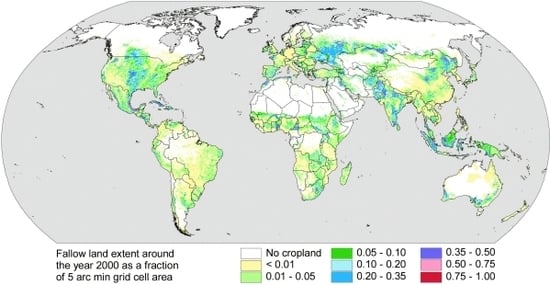Global Patterns of Cropland Use Intensity
Abstract
:1. Introduction
2. Data and Methods
2.1. Data Used in this Analysis
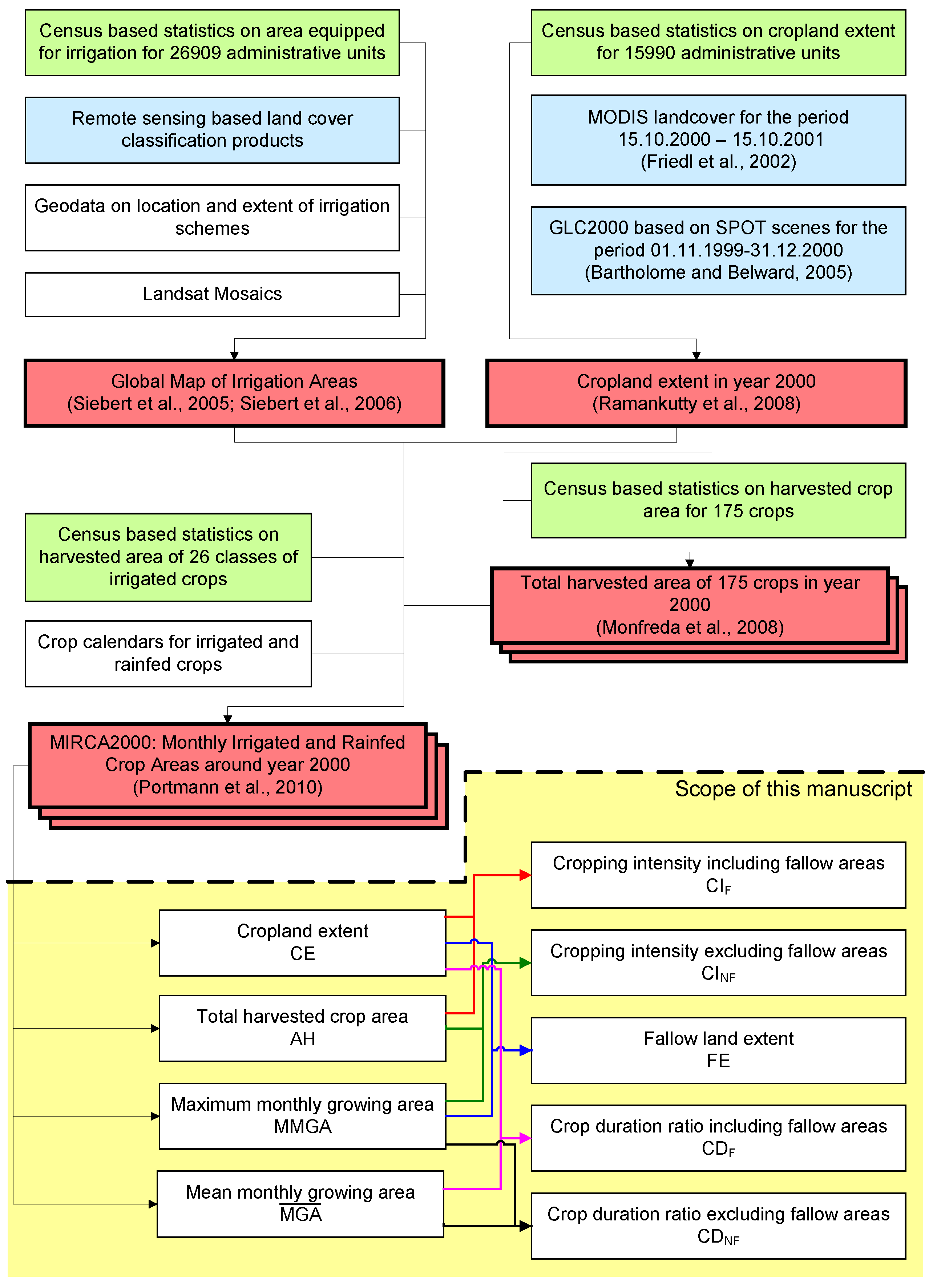
- -
- In each month and grid cell the sum of crop-specific irrigated areas is lower than or equal to the area equipped for irrigation.
- -
- In each grid cell and month the sum of crop-specific irrigated and rainfed areas is lower than or equal to the cropland extent.
- -
- In each grid cell and for each crop class the annual sum of the irrigated and rainfed harvested crop area is equal to the total (rainfed and irrigated) harvested area of the specific crop [19].
2.2. Methods Used to Compute Cropping Intensities, Crop Duration Ratios and Extent of Fallow Land
3. Results
| Region | CE (1,000 km2) | FE (1,000 km2) | CIF (yr−1) | CINF (yr−1) | CDF (-) | CDNF (-) |
| AFRICA | 2,318 | 777 | 0.72 | 1.09 | 0.41 | 0.62 |
| Eastern | 550 | 198 | 0.71 | 1.11 | 0.39 | 0.61 |
| Middle | 280 | 129 | 0.54 | 0.99 | 0.35 | 0.65 |
| Northern | 420 | 161 | 0.76 | 1.22 | 0.42 | 0.69 |
| Southern | 180 | 106 | 0.45 | 1.10 | 0.27 | 0.64 |
| Western | 889 | 184 | 0.83 | 1.05 | 0.47 | 0.59 |
| AMERICA | 4,051 | 1,159 | 0.73 | 1.02 | 0.47 | 0.65 |
| Caribbean | 79 | 34 | 0.61 | 1.08 | 0.46 | 0.81 |
| Central | 460 | 249 | 0.49 | 1.06 | 0.27 | 0.60 |
| Northern | 2,278 | 615 | 0.73 | 1.00 | 0.49 | 0.67 |
| South | 1,234 | 260 | 0.82 | 1.04 | 0.50 | 0.64 |
| ASIAa | 6,201 | 1,612 | 0.94 | 1.26 | 0.50 | 0.68 |
| Central | 352 | 119 | 0.72 | 1.08 | 0.53 | 0.80 |
| Eastern | 1,726 | 405 | 1.04 | 1.35 | 0.52 | 0.68 |
| South-Eastern | 1,218 | 392 | 0.80 | 1.17 | 0.48 | 0.71 |
| Southern | 2,445 | 550 | 1.00 | 1.29 | 0.50 | 0.64 |
| Westerna | 461 | 146 | 0.74 | 1.08 | 0.50 | 0.73 |
| EUROPEb | 3,088 | 729 | 0.77 | 1.00 | 0.56 | 0.74 |
| Easternb | 2,083 | 594 | 0.72 | 1.00 | 0.55 | 0.76 |
| Northern | 216 | 36 | 0.84 | 1.00 | 0.59 | 0.71 |
| Southern | 430 | 73 | 0.84 | 1.02 | 0.59 | 0.71 |
| Western | 359 | 26 | 0.93 | 1.01 | 0.63 | 0.67 |
| OCEANIA | 342 | 143 | 0.75 | 1.29 | 0.42 | 0.72 |
| WORLD | 16,000 | 4,419 | 0.82 | 1.13 | 0.49 | 0.68 |
- a
- excluding Russian Federation
- b
- including Russian Federation
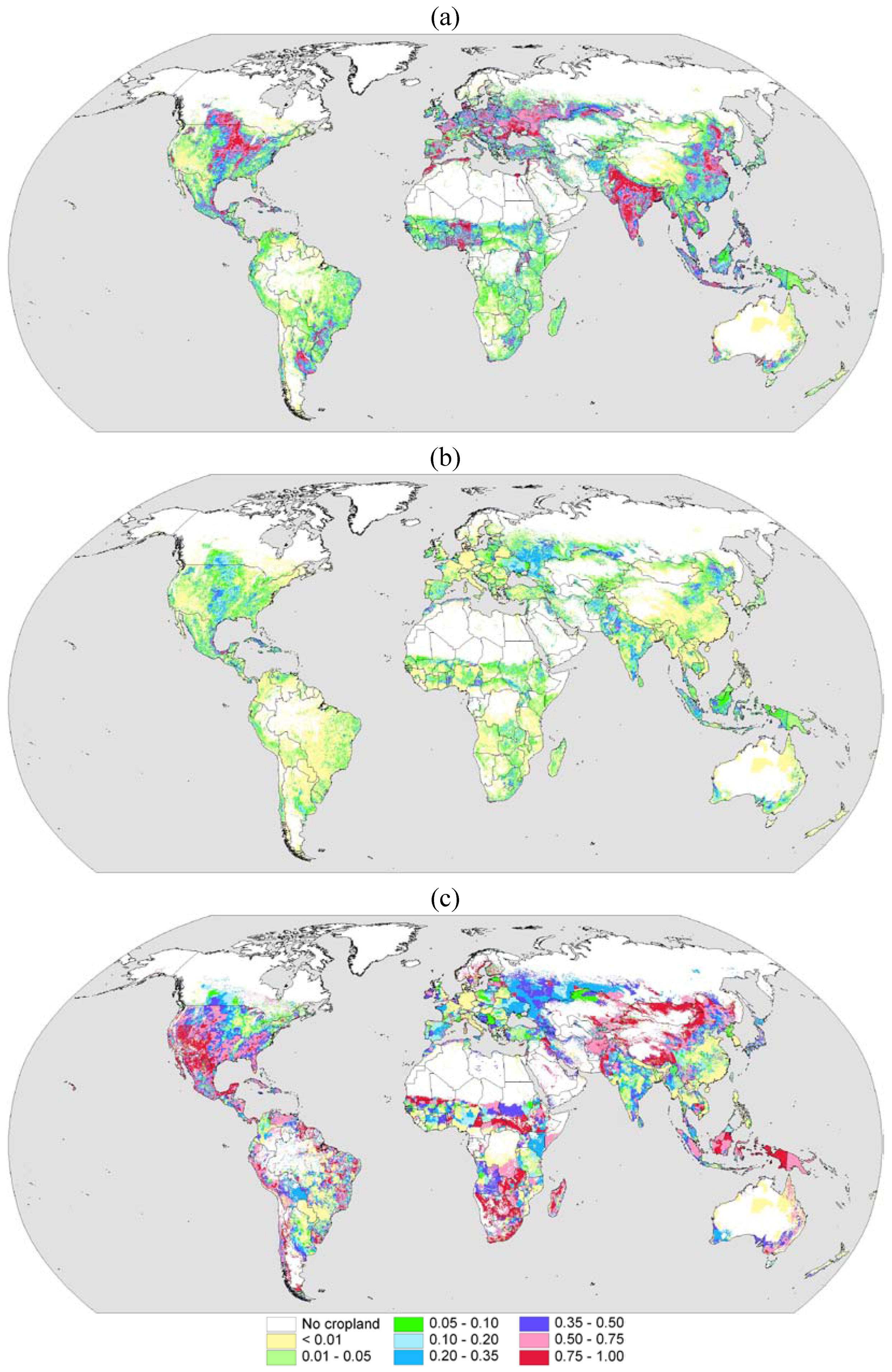
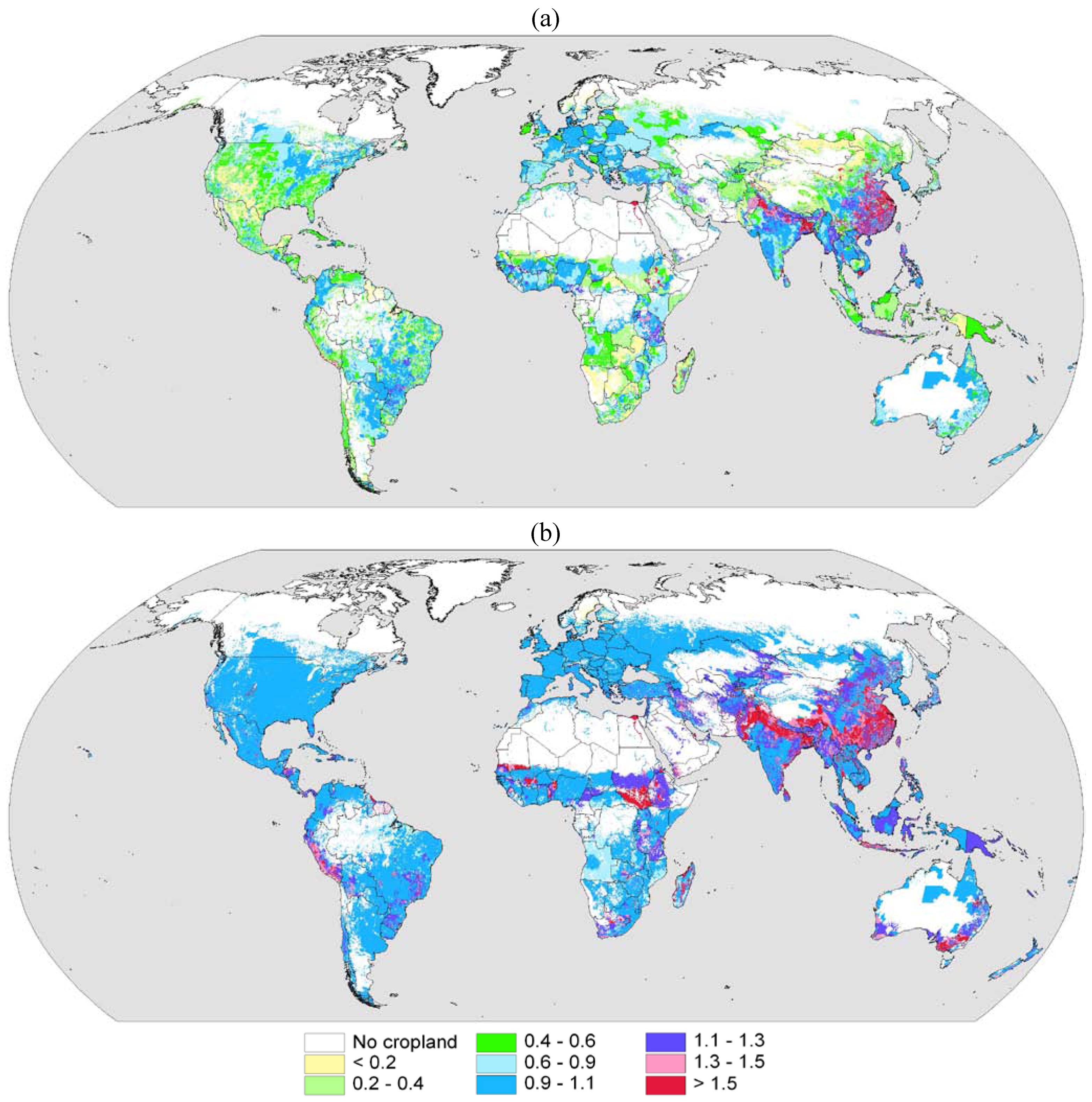
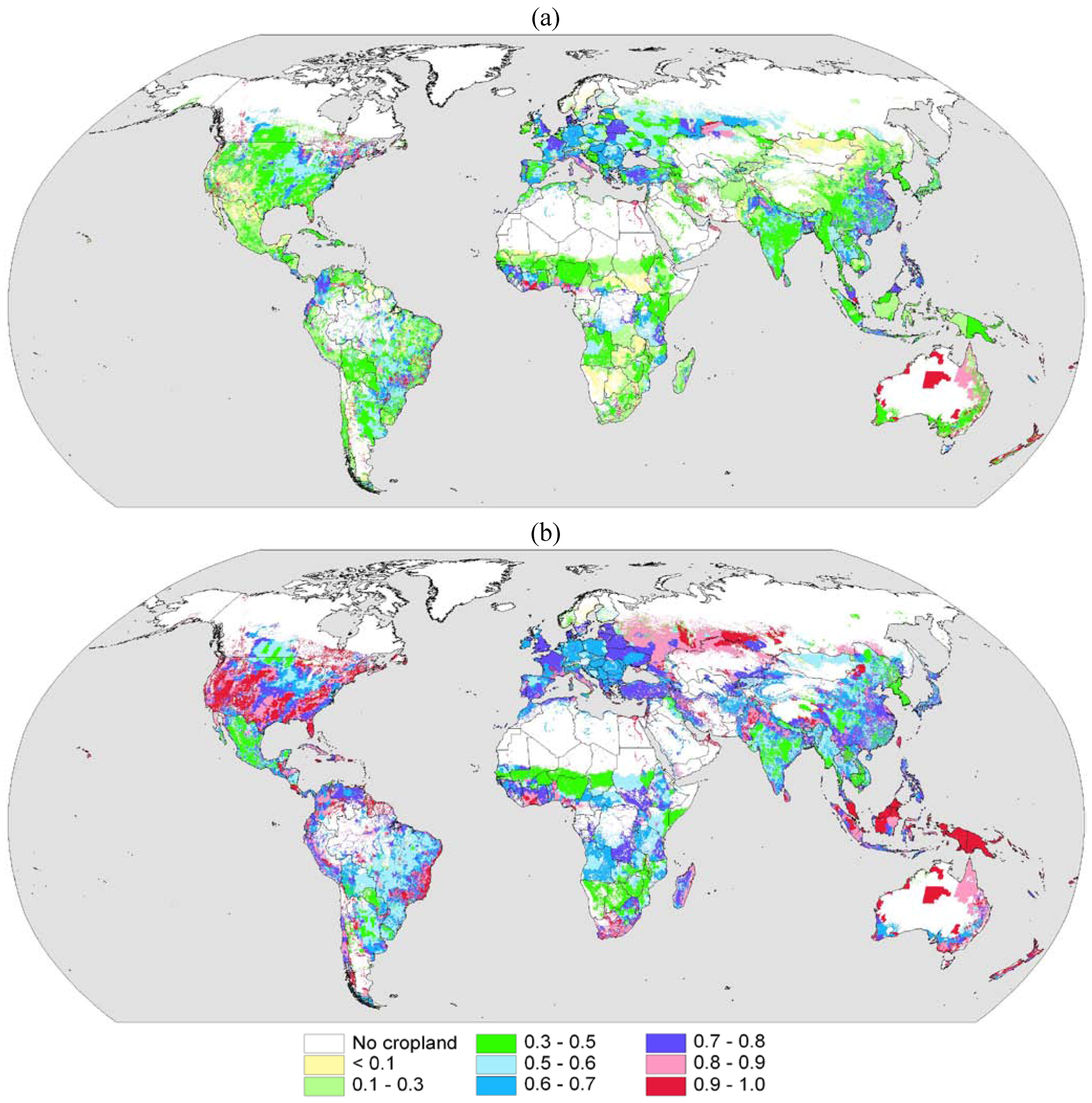
4. Discussion
4.1. Comparison to Independent Data
4.2. Limitations of the Analysis
4.3. Satellite Remote Sensing
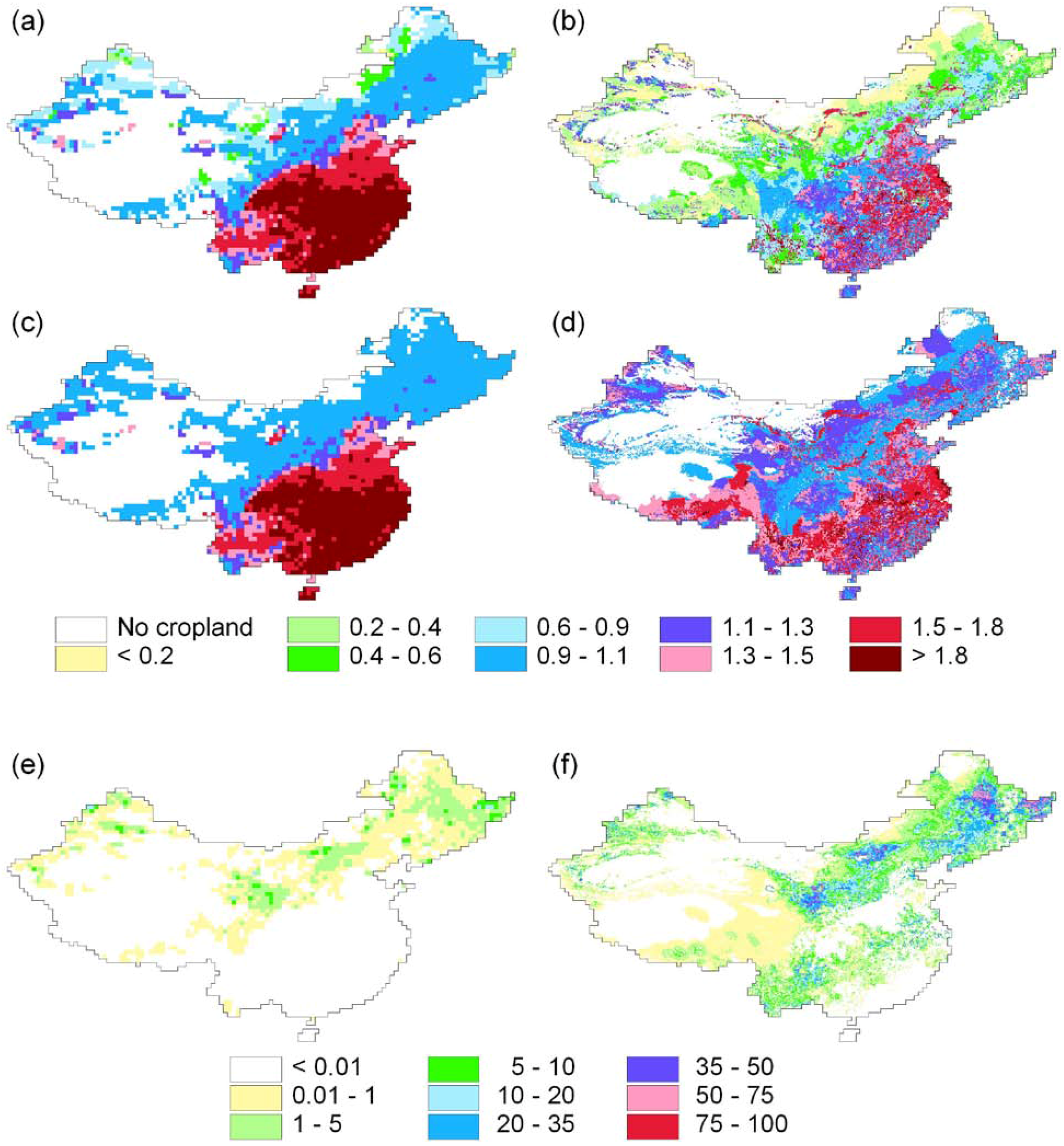
4.4. Relevance of Study Results for Agricultural Land Management
5. Conclusions
Acknowledgements
References
- FAO. World Agriculture: Towards 2030/2050; Interim Report; Food and Agriculture Organization of the United Nations: Rome, Italy, 2006. [Google Scholar]
- Keyzer, M.A.; Merbis, M.D.; Pavel, I.F.P.W.; van Wesenbeeck, C.F.A. Diet shifts towards meat and the effects on cereal use: Can we feed the animals in 2030? Ecol. Econ. 2005, 55, 187–202. [Google Scholar] [CrossRef]
- FAO. The State of Food and Agriculture 2008; Food and Agriculture Organization of the United Nations: Rome, Italy, 2008. [Google Scholar]
- Ragauskas, A.J.; Williams, C.K.; Davison, B.H.; Britovsek, G.; Cairney, J.; Eckert, C.A.; Frederick, W.J., Jr.; Hallett, J.P.; Leak, D.J.; Liotta, C.L.; Mielenz, J.R.; Murphy, R.; Templer, R.; Tschaplinski, T. The path forward for biofuels and biomaterials. Science 2007, 311, 484–489. [Google Scholar] [CrossRef] [PubMed]
- Liu, J.; Savenije, H.H.G. Food consumption patterns and their effect on water requirement in China. Hydrol. Earth Syst. Sci. 2008, 12, 887–898. [Google Scholar] [CrossRef]
- Koning, N.B.J.; Van Ittersum, M.K.; Becx, G.A.; van Boekel, M.A.J.S.; Brandenburg, W.A.; van den Broek, J.A.; Goudriaan, J.; van Hofwegen, G.; Jongeneel, R.A.; Schiere, J.B.; Smies, M. Long-term global availability of food: Continued abundance or new scarcity? NJAS-Wageningen. Life Sci. 2008, 55, 229–292. [Google Scholar] [CrossRef]
- Khan, S.; Hanjra, M.A. Footprints of water and energy inputs in food production—Global perspectives. Food Policy 2009, 34, 130–140. [Google Scholar] [CrossRef]
- Rockström, J.; Falkenmark, M. Semiarid crop production from a hydrological perspective: Gap between potential and actual yields. Crit. Rev. Plant Sci. 2000, 19, 319–346. [Google Scholar] [CrossRef]
- Rost, S.; Gerten, D.; Hoff, H.; Lucht, W.; Falkenmark, M.; Rockström, J. Global potential to increase crop production through water management in rainfed agriculture. Environ. Res. Lett. 2009, 4, 1–9. [Google Scholar] [CrossRef]
- Bouwman, A.F.; Beusen, A.H.W.; Billen, G. Human alteration of the global nitrogen and phosphorus soil balances for the period 1970–2050. Global Biogeochem. Cy. 2009, 23. [Google Scholar] [CrossRef]
- Neumann, K.; Verburg, P.H.; Stehfest, E.; Müller, C. The yield gap of global grain production: A spatial analysis. Agr. Syst. 2010, 103, 316–326. [Google Scholar] [CrossRef]
- Bruun, T.B.; Mertz, O.; Elberling, B. Linking yields of upland rice in shifting cultivation to fallow length and soil properties. Agr. Ecosyst. Environ. 2006, 113, 139–149. [Google Scholar] [CrossRef]
- Styger, E.; Rakotondramasy, H.M.; Pfeffer, M.J.; Fernandes, E.C.M.; Bates, D.M. Influence of slash-and-burn farming practices on fallow succession and land degradation in the rainforest region of Madagascar. Agr. Ecosyst. Environ. 2007, 119, 257–269. [Google Scholar] [CrossRef]
- Hiernaux, P.; Ayantunde, A.; Kalilou, A.; Mougin, E.; Gerard, B.; Baup, F.; Grippa, M.; Djaby, B. Trends in productivity of crops, fallow and rangelands in Southwest Niger: Impact of land use, management and variable rainfall. J. Hydrol. 2009, 375, 65–77. [Google Scholar] [CrossRef] [Green Version]
- Tanaka, K. Transformation of rice-based cropping patterns in the Mekong Delta: From intensification to diversification. Southeast Asian Stud. 1995, 33, 363–378. [Google Scholar]
- Siebert, S.; Nagieb, M.; Buerkert, A. Climate and irrigation water use of a mountain oasis in northern Oman. Agr. Water Manage. 2007, 89, 1–14. [Google Scholar] [CrossRef]
- Agarwal, B. Tractors, tubewells and cropping intensity in the Indian Punjab. J. Dev. Stud. 1984, 20, 290–302. [Google Scholar] [CrossRef]
- FAO. FAOSTAT Database. Food and Agriculture Organization of the United Nations. Available online: http://faostat.fao.org (accessed on 4 February 2010).
- Portmann, F.T.; Siebert, S.; Döll, P. MIRCA2000—Global monthly irrigated and rainfed crop areas around the year 2000: a new high-resolution dataset for agricultural and hydrological modelling. Global Biogeochem. Cy. 2010, 24. [Google Scholar] [CrossRef]
- Monfreda, C.; Ramankutty, N.; Foley, J.A. Farming the planet: 2. Geographic distribution of crop areas, yields, physiological types, and net primary production in the year 2000. Global Biogeochem. Cy. 2008, 22. [Google Scholar] [CrossRef]
- Ramankutty, N.; Evan, A.T.; Monfreda, C.; Foley, J.A. Farming the planet: 1. Geographic distribution of global agricultural lands in the year 2000. Global Biogeochem. Cy. 2008, 22. [Google Scholar] [CrossRef]
- Siebert, S.; Döll, P.; Hoogeveen, J.; Faures, J.M.; Frenken, K.; Feick, S. Development and validation of the global map of irrigation areas. Hydrol. Earth Syst. Sci. 2005, 9, 535–547. [Google Scholar] [CrossRef]
- Siebert, S.; Hoogeveen, J.; Frenken, K. Irrigation in Africa, Europe and Latin America. Update of the Digital Global Map of Irrigation Areas to Version 4; Institute of Physical Geography, University of Frankfurt (Main): Frankfurt, Germany, 2006. [Google Scholar]
- USDA. Agricultural Census 2002 Database. United States Department of Agriculture. Available online: http://www.agcensus.usda.gov/Publications/2002/index.asp (accessed on 4 February 2010).
- EUROSTAT Agriculture Database. Statistical Office of the European Communities. Available online: http://epp.eurostat.ec.europa.eu/portal/page/portal/agriculture/data/database (accessed on 4 February 2010).
- NIC. Agricultural Census Database. National Informatics Centre, Department of Agriculture & Cooperation: New Delhi, India. Available online: http://agcensus.nic.in/database.html (accessed on 4 February 2010).
- Lawrence, D.; Radel, C.; Tully, K.; Schmook, B.; Schneider, L. Untangling a decline in tropical forest resilience: Constraints on the sustainability of shifting cultivation across the globe. Biotropica 2010, 42, 21–30. [Google Scholar] [CrossRef]
- Filer, C.; Keenan, R.J.; Allen, B.J.; Mc Alpine, J.R. Deforestation and forest degradation in Papua New Guinea. Ann. For. Sci. 2009, 66. [Google Scholar] [CrossRef]
- Sovu, X.; Tigabu, M.; Savadogo, P.; Oden, P.C.; Xayvongsa, L. Recovery of secondary forests on swidden cultivation fallows in Laos. Forest Ecol. Manag. 2009, 258, 2666–2675. [Google Scholar] [CrossRef]
- Tchabi, A.; Burger, S.; Coyne, D.; Hountondji, F.; Lawouin, L.; Wiemken, A.; Oehl, F. Promiscuous arbuscular mycorrhizal symbiosis of yam (Dioscorea spp.), a key staple crop in West Africa. Mycorrhiza 2009, 19, 375–392. [Google Scholar] [CrossRef] [PubMed]
- Schmidt-Vogt, D.; Leisz, S.J.; Mertz, O.; Heinimann, A.; Thiha, T.; Messerli, P.; Epprecht, M.; Cu, P.V.; Chi, V.K.; Hardiono, M.; Dao, T.M. An assessment of trends in the extent of swidden in Southeast Asia. Hum. Ecol. 2009, 37, 269–280. [Google Scholar] [CrossRef]
- Young, A. Is there really spare land? A critique of estimates of available cultivable land in developing countries. Environ. Dev. Sustain. 1999, 1, 3–18. [Google Scholar] [CrossRef]
- Messerli, P.; Heinimann, A.; Epprecht, M. Finding homogeneity in heterogeneity—A new approach to quantifying landscape mosaics developed for the Lao PDR. Hum. Ecol. 2009, 37, 291–304. [Google Scholar] [CrossRef] [PubMed] [Green Version]
- Canisius, F.; Turral, H.; Molden, D. Fourier analysis of historical NOAA time series data to estimate bimodal agriculture. Int. J. Remote Sens. 2007, 28, 5503–5522. [Google Scholar] [CrossRef]
- Zhang, X.; Friedl, M.A.; Schaaf, C.B. Global vegetation phenology from Moderate Resolution Imaging Spectroradiometer (MODIS): Evaluation of global patterns and comparison with in situ measurements. J. Geophys. Res. 2006, 111, G04017. [Google Scholar] [CrossRef]
- Yan, H.M.; Fu, Y.L.; Xiao, X.M.; Huang, H.Q.; He, H.L.; Ediger, L. Modeling gross primary productivity for winter wheat-maize double cropping system using MODIS time series and CO2 eddy flux tower data. Agr. Ecosyst. Environ. 2009, 129, 391–400. [Google Scholar] [CrossRef]
- Xiao, X.M.; Boles, S.; Frolking, S.; Li, C.S.; Babu, J.Y.; Salas, W.; Moore, B. Mapping paddy rice agriculture in South and Southeast Asia using multi-temporal MODIS images. Remote Sens. Environ. 2006, 100, 95–113. [Google Scholar] [CrossRef]
- Frolking, S.; Qiu, J.J.; Boles, S.; Xiao, X.M.; Liu, J.Y.; Zhuang, Y.H.; Li, C.S.; Qin, X.G. Combining remote sensing and ground census data to develop new maps of the distribution of rice agriculture in China. Global Biogeochem. Cy. 2002, 16. [Google Scholar] [CrossRef]
- Thenkabail, P.S.; Biradar, C.M.; Noojipady, P.; Dheeravath, V.; Li, Y.J.; Velpuri, M.; Gumma, M.; Gangalakunta, O.R.P.; Turral, H.; Cai, X.L.; Vithanage, J.; Schull, M.A.; Dutta, R. Global irrigated area map (GIAM), derived from remote sensing, for the end of the last millennium. Int. J. Remote Sens. 2009, 30, 3679–3733. [Google Scholar] [CrossRef]
- Friedl, M.A.; McIver, D.K.; Hodges, J.C.F.; Zhang, X.Y.; Muchoney, D.; Strahler, A.H.; Woodcock, C.E.; Gopal, S.; Schneider, A.; Cooper, A.; Baccini, A.; Gao, F.; Schaaf, C. Global land cover mapping from MODIS: algorithms and early results. Remote Sens. Environ. 2002, 83, 287–302. [Google Scholar] [CrossRef]
- Salas, W.; Boles, S.; Li, C.S.; Yeluripati, J.B.; Xiao, X.M.; Frolking, S.; Green, P. Mapping and modelling of greenhouse gas emissions from rice paddies with satellite radar observations and the DNDC biogeochemical model. Aquatic Conserv: Mar. Freshw. Ecosyst. 2007, 17, 319–329. [Google Scholar] [CrossRef]
- Zhang, Y.; Wang, C.; Wu, J.; Qi, J.; Salas, W.A. Mapping paddy rice with multitemporal ALOS/PALSAR imagery in southeast China. Int. J. Remote Sens. 2009, 30, 6301–6315. [Google Scholar] [CrossRef]
- Ozdogan, M.; Woodcock, C.E. Resolution dependent errors in remote sensing of cultivated areas. Remote Sens. Environ. 2006, 103, 203–217. [Google Scholar] [CrossRef]
- USDA. China Agricultural and Economic Data. Economic Research Service of the United States Department of Agriculture. Available online: http://www.ers.usda.gov/Data/China/ (accessed on 28 April 2010).
- China Statistical Yearbook–2008; National Bureau of Statistics of China, Bejing, China. Available online: http://www.stats.gov.cn/tjsj/ndsj/2008/indexeh.htm (accessed on 28 April 2010).
- Fedoroff, N.V.; Battisti, D.S.; Beachy, R.N.; Cooper, P.J.M.; Fischhoff, D.A.; Hodges, C.N.; Knauf, V.C.; Lobell, D.; Mazur, B.J.; Molden, D.; Reynolds, M.P.; Ronald, P.C.; Rosegrant, M.W.; Sanchez, P.A.; Vonshak, A.; Zhu, J.K. Radically rethinking agriculture for the 21st century. Science 2010, 327, 833–834. [Google Scholar] [CrossRef] [PubMed]
- Godfray, H.C.J.; Beddington, J.R.; Crute, I.R.; Haddad, L.; Lawrence, D.; Muir, J.F.; Pretty, J.; Robinson, S.; Thomas, S.M.; Toulmin, C. Food security: the challenge of feeding 9 billion people. Science 2010, 327, 812–818. [Google Scholar] [CrossRef] [PubMed]
- Ruddiman, W.F.; Ellis, E.C. Effect of per-capita land use changes on Holocene forest clearance and CO2 emissions. Quaternary Sci. Rev. 2009, 28, 3011–3015. [Google Scholar] [CrossRef]
- Cassman, K.G. Ecological intensification of cereal production systems: Yield potential, soil quality, and precision agriculture. Proc. Nat. Acad. Sci. USA 1999, 96, 5952–5959. [Google Scholar] [CrossRef] [PubMed]
© 2010 by the authors; licensee MDPI, Basel, Switzerland. This article is an open access article distributed under the terms and conditions of the Creative Commons Attribution license (http://creativecommons.org/licenses/by/3.0/).
Share and Cite
Siebert, S.; Portmann, F.T.; Döll, P. Global Patterns of Cropland Use Intensity. Remote Sens. 2010, 2, 1625-1643. https://doi.org/10.3390/rs2071625
Siebert S, Portmann FT, Döll P. Global Patterns of Cropland Use Intensity. Remote Sensing. 2010; 2(7):1625-1643. https://doi.org/10.3390/rs2071625
Chicago/Turabian StyleSiebert, Stefan, Felix T. Portmann, and Petra Döll. 2010. "Global Patterns of Cropland Use Intensity" Remote Sensing 2, no. 7: 1625-1643. https://doi.org/10.3390/rs2071625



